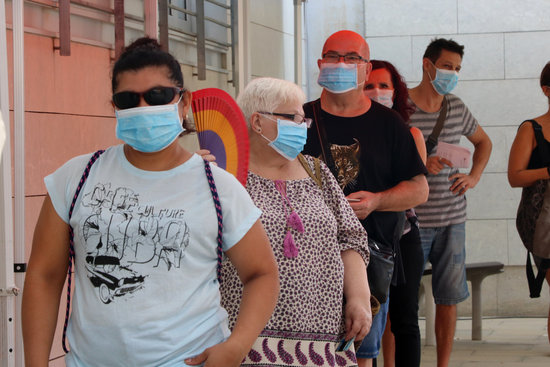What Covid-19 restrictions are in place and where
Here's a list of towns and counties under tighter rules than the rest of Catalonia

Note: On October 14, the Catalan government announced that new coronavirus restrictions would be brought in across Catalonia. As a result, this article is no longer being updated. See here for the measures in force. Last update: October 19, 2020.
All across Catalonia, measures to prevent the spread of Covid-19 are in place, starting with the compulsory use of face masks and the closure of night clubs, as well as subsequent restrictions like the limitation of smoking in public and the curfew on restaurants.
But some towns and regions are currently under tighter rules due to health concerns.
In mid-July, fifteen municipalities in the Barcelona metropolitan area and much of the western Segrià and Noguera counties were placed under more strict measures.
On August 25 additional restrictions were put in place in three towns in the Vallès Oriental area, north of Barcelona.
On September 14, health authorities extended the restrictions to Girona and Salt, in Northern Catalonia. Two days later, on September 16, it was announced that restrictions in much of Noguera were to be extended again but lifted those in Segrià, including the city of Lleida.
Restrictions were extended to La Cerdanya county, in northern Catalonia, on September 23.
On September 23, Civil Protection approved limiting social gatherings of over 6 people in a measure that applies to all of Catalonia.
As of September 30, Vic and Manlleu also have 50% capacity limits in place at restaurants, sports activities, and religious ceremonies.
Civil Protection announced it was extending measures to three southern Catalonia towns - Tortosa, Amposta, and Roquetes - on October 5.
On October 12, a 50% capacity limit for restaurants and religious events was announced for 15 municipalities in Vallès Occidental.
The tighter restrictions now affect 4.11 million people in Catalonia, over 53% of the population.
Take a look at this guide, last updated on October 12, 2020:
Where restrictions currently apply
- Barcelona's metropolitan area (2.87 million people): Barcelona, l'Hospitalet de Llobregat, Montcada i Reixac, Viladecans, el Prat de Llobregat, Sant Boi de Llobregat, Sant Joan Despí, Cornellà de Llobregat, Sant Just Desvern, Esplugues de Llobregat, Santa Coloma de Gramenet, Sant Adrià del Besòs, Badalona, Sant Feliu de Llobregat, Gavà and Castelldefels
- Noguera county (30,000 people): Àger, Albesa, Algerri, les Avellanes i Santa Linya, Balaguer, Bellcaire d'Urgell, Bellmunt d'Urgell, Camarasa, Castelló de Farfanya, Cubells, Ivars de Noguera, Menàrguens, Montgai, Os de Balaguer, Penelles, la Sentiu de Sió, Torrelameu, Térmens and Vallfogona de Balaguer
- Gironès (133,000 people): Girona and Salt
- Osona (67,000 people): Vic and Manlleu
- Vallès Oriental (98,000 people): Canovelles, Granollers and les Franqueses del Vallès
- Vallès Occidental (836,000 people): Sabadell, Terrassa, Badia del Vallès, Barberà del Vallès, Castellar del Vallès, Castellbisbal, Cerdanyola del Vallès, Matadepera, Polinyà, Ripollet, Rubí, Sant Cugat del Vallès, Sant Quirze del Vallès, Sentmenat, and Viladecavalls.
- La Cerdanya (18,000 people): Alp, Bellver de Cerdanya, Bolvir, Das, Fontanals de Cerdanya, Ger, Guils de Cerdanya, Isòvol, Lles de Cerdanya, Llívia, Meranges, Montellà i Martinet, Prats i Sansor, Prullans, Puigcerdà, Riu de Cerdanya, Urús
- Terres de l'Ebre (62,000 people): Tortosa, Roquetes and Amposta
Recommended
Generally speaking, the public in these areas is advised to stay at home.
It is recommended that people only leave the house for the following reasons: to work, for health and care reasons, to buy essential food and drink, to go to the bank, for other purchases by appointment, to do sport outdoors, to look after allotments and for force majeure, as well as procedures that cannot be postponed, like exams, renewing ID and permits.
Banned
Meetings of over 6 people in both private and public are prohibited, except for work or on public transport. This applies to all of Catalonia as of September 23.
Allowed but with restrictions
Bars and restaurants can open, but with a maximum capacity of 50%, both indoors and outdoors on terraces. No food or drink can be served at the bar and customers should be able to maintain 1.5-meter safety distances.
Hotels and tourist apartments in all affected areas are also allowed to operate, but at 50% capacity in communal areas.
Shops are recommended to only accept clients by appointment.
Places offering cultural events and shows, as well as establishments putting on fun activities, sports centers, gyms, and similar venues can only open at 50 to 70% of their capacity.
In the 15 affected municipalities in Barcelona's metropolitan area and the three towns in Vallès Oriental, the maximum capacity is 70%, while in the affected towns in Noguera and Gironès it remains at 50%.
In La Cerdanya, Vic, Manlleu, Tortosa, Amposta, and Roquetes religious and sporting event attendance is capped at 50%, while cultural activities have 70% capacity limits. The same restrictions apply in the affected parts of Vallès Occidental.
Tortosa will also be suspending all cultural and tourist activities organized by the local council and closing all children's play areas.